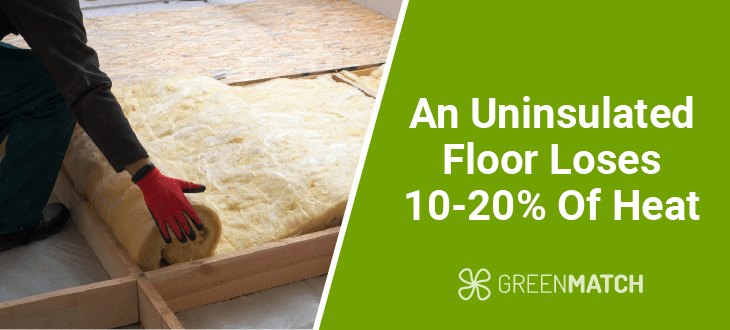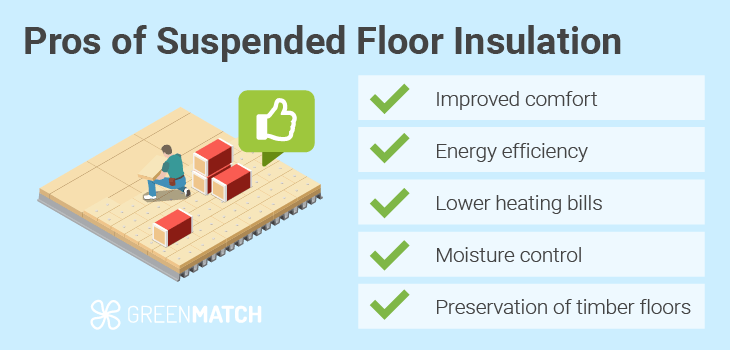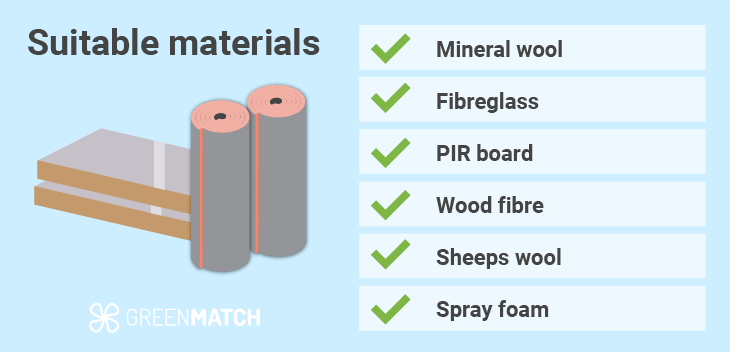Answer these simple questions and we will find you the BEST prices
Which type of solar quotes do you need?
It only takes 30 seconds
100% free with no obligation

Get Free quotes from insulation specialists near you

Save money by comparing quotes and choosing the most competitive offer

The service is 100% free and with no obligation
- GreenMatch
- Insulation
- Floor Insulation
- Suspended Floor Insulation
Suspended Floor Insulation: Costs, Benefits & Step-by-Step Guide


- A detached home can save up to £110 annually in Great Britain and £145 per year in Northern Ireland through floor insulation.
- The cost of insulating a suspended floor will vary depending on the material used, ranging from £5 to £24 per m².
- Insulating suspended floors in detached homes can result in up to £500 in savings over five years.
According to the UK’s Department for Business, Energy & Industrial Strategy, the benefits of insulating floors can be substantial for homeowners with uninsulated properties, as 10-20% of heat is lost through the floors.
Insulating suspended floors helps reduce heat loss, improve energy efficiency, and lower heating bills. Thus, insulation is an essential upgrade for improving home comfort and cutting energy costs.
This guide will explore the best floor insulation process and provide valuable insights to help you understand its advantages.
Ready to improve your home’s energy efficiency? Fill out our quick form in just 30 seconds to get up to three free quotes from trusted installers, and start enjoying the benefits of a warmer, more efficient home today. Click to get started!
- Describe your needs
- Get free quotes
- Choose the best offer
It only takes 30 seconds



What is a suspended floor, and why does this matter?
A suspended floor refers to flooring with floorboards elevated above ground level, supported by joists with an open space underneath. This design, commonly found in older UK homes, promotes air circulation to help prevent dampness from affecting the building.
However, it also makes the floor susceptible to heat loss and draughts, which can significantly reduce the home's energy efficiency.

Insulating a suspended floor is important because it can enhance home comfort, reduce energy consumption, and lower heating bills. Proper insulation minimises heat loss, eliminates draughts, and prevents condensation, which helps avoid issues such as dampness and rot on timber floors.
However, when insulating, it is essential to ensure ventilation remains intact, typically achieved through air bricks. These should remain clear to prevent moisture build-up and avoid structural problems like damp and dry rot in the timber joists. This is particularly crucial in the UK, where many homes still have suspended timber floors.
How much does insulating a suspended floor cost?
The cost of insulating a suspended floor depends on the material chosen. Each has advantages, such as thermal resistance, breathability, or eco-friendliness. Below is a breakdown of common materials used in the UK for suspended floor insulation.
| Material | Cost per m² | Cost for 10m² | Cost for 15m² | Cost for 20m² |
|---|---|---|---|---|
| PIR board | £5 - £15 | £50 - £150 | £75 - £225 | £100 - £300 |
| Fibreglass | £10 | £100 | £150 | £200 |
| Polyurethane (spray foam) | £21.5 | £215 | £322.5 | £430 |
| Mineral wool | £13 - £17.5 | £130 - £175 | £195 - £262.5 | £260 - £350 |
| Wood fibre insulation board | £12 - £24 | £120 - £240 | £180 - £360 | £240 - £480 |
| Sheep's wool | £17.5 - £22 | £175 - £220 | £262.5 - £330 | £350 - £440 |
Insulation materials

When insulating a suspended floor in the UK, the choice of material is crucial in both performance and cost. Below are the common materials and their characteristics.
- Mineral wool: Known for its fire resistance and breathability, mineral wool fits between joists to trap air, providing thermal insulation and reducing draughts. It’s excellent for preventing moisture retention and condensation issues.
- PIR boards: These rigid foam boards offer high thermal resistance and are ideal for reducing heat loss. However, they are less breathable, so ventilation must be maintained to prevent dampness.
- Sheep wool and wood fibre: These eco-friendly materials are breathable, allowing moisture to pass through, which makes them suitable for older homes with suspended timber floors. They provide excellent insulation without causing condensation.
- Fibreglass: A budget-friendly option, fibreglass is effective for thermal insulation but may require additional measures for moisture control.
- Polyurethane (spray foam): This material has one of the highest thermal resistances and is ideal for tight spaces. However, due to its non-breathable nature, monitoring moisture and ventilation is essential.
What do the savings look like?
For an average UK home, the savings from insulating a suspended timber floor are around £53-£68 per year in a mid-terrace or semi-detached house. The savings increase significantly for detached homes, up to £110 per year in Great Britain and £145 per year in Northern Ireland. This is due to the larger surface area exposed to heat loss. These savings are due to improved thermal efficiency and reduced floor heat loss.
Additionally, insulating the ground floor with good insulation materials can prevent cold drafts and help maintain a warmer internal environment during colder months, making your home more energy-efficient overall.
Material-specific savings
- Mineral wool insulation: Homeowners can save around 1,500 kWh of energy annually when insulating with mineral wool. This equates to approximately £100 per year for a typical 150m² home. Mineral wool is one of the most effective energy-saving materials due to its thermal retention properties.
- Other materials: While detailed savings for specific materials like sheep wool, rigid foam boards, and spray foam are less documented, these materials can offer similar or slightly better savings depending on their thermal resistance properties. Spray foam, for example, is highly effective but must be installed with care to avoid moisture issues.
Long-term savings impact
Over time, even modest annual savings from suspended floor insulation can add up. For instance, insulating floors can save approximately 1,500 kWh of energy annually, translating to £100 annually. Therefore, homeowners could save up to £500 in just five years, making floor insulation a worthwhile investment, especially with current energy prices.
Insulating your suspended floors is a wise decision, considering these savings. Fill out a quick form to get up to 3 free quotes in 30 seconds. It’s easy, and you can compare the best options for your home. Take advantage of these potential savings and get your quotes today!
- Describe your needs
- Get free quotes
- Choose the best offer
It only takes 30 seconds



Pros and cons of suspended (timber) floor insulation
Suspended timber floor insulation can offer significant benefits regarding energy efficiency and home comfort, but it also has some drawbacks. Below are the pros and cons of insulating a suspended timber floor.
- Energy efficiency: You can save up to £100 per year on energy bills by reducing heat loss
- Draught reduction: Helps eliminate cold drafts, improving home comfort
- Condensation control: Breathable materials like mineral wool reduce moisture build-up
- Eco-friendly options: Sustainable materials like sheep wool are available
- Installation disruption: Requires lifting floorboards, which can be invasive
- Potential for gaps: Improper installation can leave gaps between insulation and joists, reducing its effectiveness
- Ventilation risks: Poor installation can block airflow, leading to dampness
How to insulate a suspended floor?
Insulating a suspended timber floor improves energy efficiency and reduces draughts in your home. You can achieve effective insulation and prevent heat loss by following these simple steps. Here's a quick guide to help you get started:
- Identify the floor type: Confirm your floor is suspended timber by checking for air bricks or ventilation gaps under the floor level.
- Lift the floorboards: Carefully lift the floorboards to access the joists, ensuring minimal damage.
- Inspect for dampness or damage: Check the joists for signs of dampness or rot. Fix any issues before continuing.
- Install netting or battens: Attach netting or battens under the joists to support the insulation material.
- Cut and fit insulation: Fit insulation snugly between joists with no gaps. The typical thickness for suspended floors is around 100mm. For optimal heat retention with underfloor heating insulation thickness, 80-100mm is recommended for rigid materials like PIR boards.
- Install a vapour control layer (optional): Add a vapour control layer to help control moisture and improve airtightness.
- Replace the floorboards: Securely refit them, ensuring a tight fit to avoid draughts.
- Ensure proper ventilation: Ensure all air bricks and gaps remain unblocked for airflow.
While insulating a suspended timber floor can be done DIY, hiring a professional ensures the job is done safely and effectively. Professionals can identify hidden structural issues or dampness early on and ensure the insulation is fitted correctly and ventilated, preventing long-term damage and maximising energy efficiency.
Is it worth installing floor insulation for suspended floors?
Yes, installing insulation for suspended floors is a worthwhile investment. It significantly improves energy efficiency, reduces draughts, and can save you up to £100 per year on energy bills, depending on the insulation material and the size of your home.
Additionally, it enhances home comfort by preventing cold air from seeping through the floorboards and can increase the value of your property due to improved thermal performance.
While an initial cost is involved, the long-term savings, combined with the reduction in CO2 emissions and the potential to increase your home's value, make it a wise choice, especially with rising energy prices.
With these benefits in mind, now is the perfect time to receive up to three free quotes from professional installers by completing our quick 30-second form! This will help you discover the best home solution and reduce your energy bills. Click to get started!
- Describe your needs
- Get free quotes
- Choose the best offer
It only takes 30 seconds



FAQ
The best insulation for suspended floors depends on your needs. Mineral wool is popular for its fire resistance and breathability, while PIR boards offer high thermal resistance. Sheep wool and wood fibre are excellent breathable alternatives for eco-friendly options.
Without insulation, a suspended floor can lose up to 10-20% of a home’s heat. Insulating suspended floors can save around 1,500 kWh annually, reducing energy bills. Proper insulation minimises heat loss, making your home more energy-efficient.
If installed correctly, suspended floor insulation does not cause dampness. Proper ventilation prevents moisture buildup; breathable materials like sheep wool also help prevent condensation.
The typical insulation thickness for suspended floors is around 100mm, depending on the material used. PIR boards and similar rigid insulation often range from 80-100mm for good thermal performance.

Nicole Bea Kerr is a content writer for Greenmatch, leveraging her experience in B2B journalism and editing. She is interested in bringing more awareness to sustainability through informative narratives.
We strive to connect our customers with the right product and supplier. Would you like to be part of GreenMatch?

- Suspended Floor Insulation: Costs, Benefits & Step-by-Step Guide
- What is a suspended floor, and why does this matter?
- How much does insulating a suspended floor cost?
- What do the savings look like?
- Pros and cons of suspended (timber) floor insulation
- How to insulate a suspended floor?
- Is it worth installing floor insulation for suspended floors?
- FAQ
